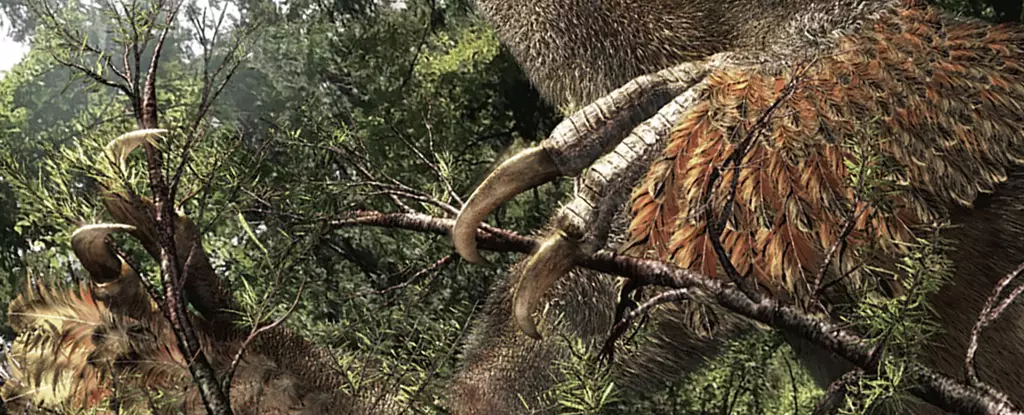In an astonishing revelation for paleontology, scientists have unveiled Duonychus tsogtbaatari, a newly identified species of feathered, bipedal dinosaur characterized by its peculiar two-fingered hands adorned with astonishingly large, claw-like talons. Found in the arid expanses of southeastern Mongolia, specifically in the Bayanshiree Formation of the Gobi Desert, this fossil pushes the boundaries of our understanding of dinosaur morphology. Unlike its therizinosaur cousins—all previous members featured three fingers—Duonychus represents a striking deviation from established evolutionary patterns. It is a stark reminder that nature often resorts to experimentation, with each discovery peeling back layers of evolutionary history.
Exceptional Fossil Preservation
One of the most groundbreaking aspects of this find is the extraordinary preservation of its claws. Researchers unearthed a fossil so well-preserved that the keratin sheath—a protective layer typically lost to time—remains discernible, revealing talons reaching nearly 30 centimeters (12 inches) in length. This finding is not merely a testimony to the age of the specimen, which has been dated to approximately 90 to 95 million years ago, but it also sheds light on the environmental conditions that allowed for such remarkable preservation. The unique lithified mud and clay deposits of the Bayanshiree Formation acted as a bastion for organic materials, defying the odds of decay.
The Functional Mystery of Two Fingers
The decision of Duonychus to evolve with only two fingers, instead of the common three, raises fascinating questions about its lifestyle and survival strategies. Researchers postulate that its unusual digital arrangement may reflect a specialized feeding method, enabling the dinosaur to grasp vegetation with a dexterity previously unseen among therizinosaurs. This adaptation invites speculation: could the dinosaur have engaged in feeding behaviors analogous to modern-day sloths or chameleons, utilizing its formidable claws to manipulate foliage effectively?
This feature challenges the preconceived notion of how dinosaurs interacted with their environment and extends an invitation to rethink their ecological roles. Traditional beliefs hold that claws evolved primarily for predation or defense. The insight that they may have served for grasping plants and feeding is an ethical paradigm shift, allowing us to appreciate the delicate dance of survival that these ancient creatures performed.
A Broader Perspective on Dinosaur Evolution
The discovery of Duonychus tsogtbaatari also provides critical insights into the diverse evolutionary paths of theropods. Only a handful of dinosaur species are known to exhibit similar digit reduction, often perceived as anomalies, each dependent on vastly different evolutionary pressures. The uniqueness of this new species serves as a reminder that evolution can lead to unpredictable results—even within established lineages. The prevalence of three-fingered dinosaurs has shaped our understanding, often leading researchers to overlook exceptions that defy expectations.
Additionally, this discovery has implications for our comprehension of dinosaur behavior and social interactions. Researchers have suggested that these claws might not just be utilitarian tools for feeding but could have played roles in courtship, territorial displays, and even playful interactions among individuals. The notion that such iconic creatures exhibited behavior akin to modern avian species opens yet another avenue for exploration and underscores nature’s creativity in crafting survival strategies.
Implications for Paleontological Research
As we delve deeper into this feathered marvel, it becomes evident that Duonychus tsogtbaatari is more than just a singular finding. It embodies the spirit of paleontological inquiry itself—perpetually revealing the complexities of ancient life. The advent of studies such as this enriches the narrative of dinosaur evolution, urging scientists to adopt a more inquisitive and nuanced approach to their research.
As we marvel at the awe-inspiring intricacies found in the natural world, let us also reflect on the myriad potential discoveries that lay buried beneath the earth’s surface. Each fossil holds a story waiting to be uncovered, a reminder of the dynamic evolutionary experiments that shaped—the present, and indeed our very understanding of life itself. Therefore, Duonychus tsogtbaatari is not merely interesting but essential for reevaluating our understanding of evolutionary biology and the diverse adaptations that define life on Earth.


Leave a Reply